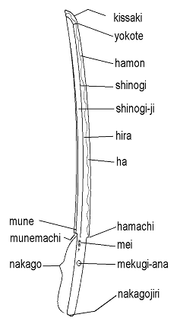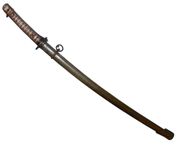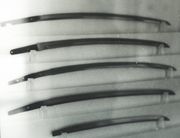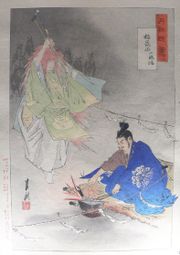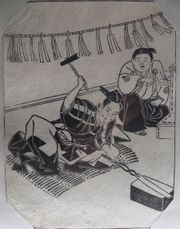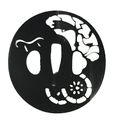Katana
2007 Schools Wikipedia Selection. Related subjects: Military History and War
Katana (刀) is the word for " sword" in the Japanese language. It is also used specifically for a type of Japanese backsword or longsword (大刀 daitō) in use after the 1400s: a curved, single-edged sword traditionally used by the samurai. Pronounced [kah-tah-nah] in the kun'yomi (Japanese reading) of the kanji 刀, the word has been adopted as a loan word by the English language; as Japanese does not have separate plural and singular forms, both "katanas" and "katana" are considered acceptable plural forms in English.
The katana was typically paired with the wakizashi or shōtō, a similarly made but shorter sword, both worn by the members of the warrior class. It could also be worn with the tantō, an even smaller similarly shaped blade. The two weapons together were called the daishō, and represented the social power and personal honour of the samurai. The long blade was used for open combat, while the shorter blade was considered a side arm, more suited for stabbing, close quarters combat, and seppuku, a form of ritual suicide.
The katana was primarily used for cutting, and intended for use with a two-handed grip. It is traditionally worn edge up. While the practical arts for using the sword for its original purpose are now obsolete, kenjutsu and iaijutsu have turned into modern martial arts. The art of drawing the katana and attacking one's enemies is iaidō.
Authentic Japanese swords are fairly uncommon today, although genuine antiques can be acquired at significant expense. Modern katana and wakizashi are only made by the few licenced practitioners that still practice making these crafted weapons today, and even the "type 98 katanas" of World War II are rare.
History of the Japanese sword
Early history
One of the oldest known Japanese forms of sword dates from the Kofun era (3rd and 4th centuries). The style, called Kashima no Tachi (鹿島の太刀), was created at the Kashima Shrine (in Ibaraki Prefecture). Before 987, examples of Japanese swords are straight chokutō or jōkotō and others with unusual shapes. In the Heian Period (8th to 11th centuries) sword-making developed through techniques brought from Siberia and Hokkaidō, territory of the Ainu people. The Ainu used Warabite-tō(蕨手刀) swords and these influenced the katana. According to legend, the Japanese sword was invented by a smith named Amakuni in 700 AD, along with the folded steel process. In reality the folded steel process and single edge swords had been brought over from China through trade. Between 987 – 1597, swords are kotō: these are considered the pinnacle of Japanese swordcraft. Early models had uneven curves with the deepest part of the curve at the hilt. As eras changed the centre of the curve tended to move up the blade.
By the twelfth century, civil war erupted, and the vast need for swords together with the ferocity of the fighting caused the highly artistic techniques of the Kamakura period (known as the Golden Age of Swordmaking) to be abandoned in favour of more utilitarian and disposable weapons. The export of katana reached its height during Muromachi period, when at least 200,000 katana were shipped to the Ming dynasty in official trade in an attempt to soak up the production of Japanese weapons and make it harder for pirates in the area to arm. The craft decayed as time progressed and firearms were introduced as a decisive force on the battlefield.
The Mongol invasions of Japan in the thirteenth century spurred further evolution of the Japanese Sword. Often forced to abandon traditional mounted archery for hand-to-hand combat, many samurai found that their swords were too delicate and prone to damage when used against the thick leather armor of the invaders. In response, Japanese swordsmiths started to adopt thinner and simpler temper lines. Certain Japanese swordsmiths of this period began to make blades with thicker backs and bigger points as a response to the Mongol threat.
New swords
In times of peace, swordsmiths returned to the making of refined and artistic blades, and the beginning of the Momoyama period saw the return of high quality creations. As the techniques of the ancient smiths had been lost during the previous period of war, these swords were called shintō, literally "new swords." These are considered inferior to most kotō, and generally coincide with a degradation in manufacturing skills. As the Edo period progressed, blade quality declined, though ornamentation was refined. The addition of engravings known as horimono was originally for religious reasons, and these were simple and tasteful. In the more complex work found on many shintō, form no longer strictly followed function.
Under the isolationist Tokugawa Shogunate, swordmaking declined along with the use of firearms. The master swordsmith Munetsugu published opinions that the arts and techniques of the shinto swords were inferior to the kotō blades, and that research should be made by all swordsmiths to rediscover the lost techniques. Munetsugu travelled the land teaching what he knew to all who would listen, and swordsmiths rallied to his cause and ushered in a second renaissance in Japanese sword smithing. With the discarding of the shintō style, and the re-introduction of old and rediscovered techniques, swords made in the kotō style between 1761 – 1876 are shinshintō, "new revival swords" or literally 'new-new swords.' These are considered superior to most shintō, but worse than true kotō.
The arrival of Matthew Perry in 1853 and the subsequent Convention of Kanagawa forcibly reintroduced Japan to the outside world; the rapid modernization of the Meiji Restoration soon followed. The Haitorei edict in 1876 all but banned carrying swords and guns on streets. Overnight, the market for swords died, many swordsmiths were left without a trade to pursue, and valuable skills were lost. Katana remained in use in some occupations such as the police force. At the same time, kendo was incorporated into police training so that police officers would have at the training necessary to properly use one.
In time, the need to arm soldiers with swords was perceived again and over the decades at the beginning of the 20th century swordsmiths again found work. These swords, derisively called gunto, were often oil tempered or simply stamped out of steel and given a serial number rather than a chiseled signature. These often look like Western cavalry sabers rather than katana, although most are just like katana, with many mass-produced and in general slightly shorter than blades of the shintō and shinshintō periods.
Military swords hand made in the traditional way are often termed as gendaitō. The craft of making swords was kept alive through the efforts of a few individuals, notably Gassan Sadakazu and Gassan Sadakatsu who were employed as Imperial artisans. These smiths produced fine works that stand with the best of the older blades for the Emperor and other high ranking officials. The students of Gassan Sadakatsu went on to be designated Intangible Cultural Assets, "Living National Treasures," as they embodied knowledge that was considered to be fundamentally important to the Japanese identity. In 1934 the Japanese government issued a military specification for the shin gunto (new army sword), the first version of which was the Type 94 Katana, and many machine- and handcrafted swords used in World War II conformed to this and later shin gunto specifications.
Recent history and modern use
Under the United States occupation at the end of World War II all armed forces in Occupied Japan were disbanded and production of katana with edges was banned except under police or government permit. The ban was overturned through a personal appeal by Dr. Homma Junji. During a meeting with General Douglas MacArthur, Dr. Homma produced blades from the various periods of Japanese history and MacArthur was able to identify very quickly what blades held artistic merit and which could be considered purely weapons. As a result of this meeting, the ban was amended so that guntō weapons would be destroyed while swords of artistic merit could be owned and preserved. Even so, many katana were sold to American soldiers at a bargain price; as of 1958 there were more Japanese swords in America than in Japan. The vast majority of these 1,000,000 or more swords were guntō, but there were still a sizable number of older swords.
Swordsmiths had been increasingly turning to producing civilian goods after the Edo period but this disarmament and subsequent regulations almost put an end to the production of katana. A few smiths did continue their trade, and Dr. Homma went on to be a founding figure of the Nihon Bijitsu Hozon Token Kai, the Society for the Preservation of Art Swords, who made it their mission to preserve the old techniques and blades. With the efforts of other like-minded individuals, the katana avoided disappearing and many swordsmiths have continued the work begun by Munetsugu, re-discovering old swordmaking techniques in the process.
Modern katana manufactured according to traditional methods are usually known as shinsakutō (newly made swords). Alternately, they can be termed shinken when they are designed for combat as opposed to iaito training swords. Some replica katana have been used in modern-day armed robberies.
Classification of Japanese swords
What generally differentiates the different swords is their length. Japanese swords are measured in units of shaku, a shaku being around 30cm or one foot). A blade shorter than 1 shaku is considered a tantō (knife). A blade longer than 1 shaku but less than 2 is considered a shōtō (short sword). The wakizashi and kodachi are in this category.
A blade longer than 2 shaku is considered a daitō, or long sword. Before 1500 most swords were worn suspended from cords on a belt, blade-down. This style is called jindachi-zukuri, and daitō worn in this fashion are called tachi (average blade length of 75 cm). From 1500 – 1867, almost all swords were worn through an obi, paired with a smaller blade. Both blades were blade-up. This style is called buke-zukuri, and all daitō worn in this fashion are katana, averaging 65 cm in blade length.
A chiisakatana is simply a shorter katana. It is longer than the wakizashi, lying between one and two shaku in length. Chiisakatana were not common weapons since usually a katana was made for a taller person or a wakizashi for a shorter person. The most common reference to a chiisakatana is a shorter katana that does not have a companion blade. They were most commonly made in the buke-zukuri mounting.
Abnormally long blades (longer than 3 shaku), usually carried across the back, are called ōdachi or nodachi. The word ōdachi is also sometimes used as a synonym for katana.
Since 1867, restrictions and/or the deconstruction of the samurai class meant that most blades have been worn jindachi-zukuri style, like Western navy officers. Recently (since 1953) there has been a resurgence in the buke-zukuri style, permitted only for demonstration purposes. Swords designed specifically to be tachi are generally kotō rather than shintō, so they are generally better manufactured and more elaborately decorated. However, these are still katana if worn in modern buke-zukuri style. The signature almost always appears on the side facing away from the body when the blade is worn, so it is possible to discern the smith's intention for the blade in this manner.
Japanese swords can be traced back to one of several provinces, each of which had its own school, traditions and 'trademarks' - e.g., the swords from Mino province were "from the start famous for their sharpness". These traditions and provinces are as follows:
- Sōshū School
- Yamato School
- Bizen School
- Yamashiro School
- Mino School (e.g. kanenobu)
- Wakimono School
Manufacturing
Katana and wakizashi were often forged with different profiles, different blade thicknesses, and varying amounts of grind. Wakizashi were not simply scaled-down katana; they were often forged in hira-zukuri or other such forms which were very rare on katana.
The daishō was not always forged together. If a samurai was able to afford a daishō, it was often composed of whichever two swords could be conveniently acquired, sometimes by different smiths and in different styles. Even when a daishō contained a pair of blades by the same smith, they were not always forged as a pair or mounted as one. Daishō made as a pair, mounted as a pair, and owned/worn as a pair, are therefore uncommon and considered highly valuable, especially if they still retain their original mountings (as opposed to later mountings, even if the later mounts are made as a pair).
Forging
The forging of a Japanese blade typically took hours or days, and was considered a sacred art. As with many complex endeavors, rather than a single craftsman, several artists were involved. There was a smith to forge the rough shape, often a second smith (apprentice) to fold the metal, a specialist polisher, and even a specialist for the edge itself. Often, there were sheath, hilt, and tsuba specialists as well.
The most famous part of the manufacturing process was the folding of the steel. Japanese swords and other edged weapons are manufactured by the Chinese method of repeatedly heating, folding and hammering the metal. This practice became popular due to the use of highly impure metals, stemming from the low temperature yielded in the smelting at that time and place. The folding did several things:
- It eliminated any bubbles in the metal.
- It homogenized the metal, spreading the elements (such as carbon) evenly throughout - increasing the effective strength by decreasing the number of potential weak points.
- It burned off many impurities, helping to overcome the poor quality of the raw Japanese steel.
- It created layers, by continuously decarburizing the surface and bringing it into the blade's interior, which gives the swords their grain (for comparison see pattern welding); however, the belief that the layered structure provides enhanced mechanical properties of the steel is false, as layers act as weld points which can only serve to weaken the integrity of the blade.
Contrary to popular belief, continued folding will not create a "super-strong" blade; once impurities are burnt off and the carbon content homogenized, further folding offers little benefit and will gradually burn out the carbon, leading eventually to a softer steel less able to hold an edge. More than about a dozen folds are uncommon and swords never have more than two dozen folds. A blade folded 12 times will have more than 4,000 'layers' underneath the initial blade to begin with. Even before this point, more layers does not equal a better sword; an even and clean composition is obtained early in the folding process, and control of carbon content has a much greater effect on the blade's functionality. Thus, the best results were usually obtained at 8-10 folds.
One of the core philosophies of the Japanese sword is that it has a single edge. This means that the rear of the sword can be used to reinforce the edge, and the Japanese took full advantage of this. When finished, the steel is not quenched or tempered in the conventional European fashion. Steel’s exact flex and strength vary dramatically with heat variation. If steel cools quickly, from a hot temperature, it becomes martensite, which is very hard but brittle. Slower, from a lower temperature, and it becomes pearlite, which has significantly more flex but does not hold an edge. To control the cooling, the sword is heated and painted with layers of sticky clay. A thin layer on the edge of the sword ensures quick cooling for a hard edge, with a thicker layer of mud on the rest of the blade causing slower cooling and softer, more flexible steel to give the blade the required flex. When the application is finished, the sword is quenched and hardens correctly. This process also makes the edge of the blade contract less than the back when cooling down, something that aids the smith in establishing the curvature of the blade.
Decoration
Almost all blades are decorated, although not all blades are decorated on the visible part of the blade. Once the blade is cool, and the mud is scraped off, the blade has designs and grooves cut into it. One of the most important markings on the sword is performed here: the file markings. These are cut into the tang, or the hilt-section of the blade, where they will be covered by a hilt later. The tang is never supposed to be cleaned: doing this can cut the value of the sword in half or more. The purpose is to show how well the blade steel ages.
Some other marks on the blade are aesthetic: signatures and dedications written in kanji and engravings depicting gods, dragons, or other acceptable beings, called horimono. Some are more practical. The presence of a so-called "blood groove" or fuller does not in actuality allow blood to flow more freely from cuts made with the sword. It leads to no demonstrable difference in ease withdrawing a blade nor reduce the sucking sound that many people believe was the reason for including such a feature in commando knives in World War II. The grooves are analogous in structure to an I beam, lessening the weight of the sword yet keeping structural integrity and strength. Furthermore the grooves (always done on both sides of the blade) make a whistling sound when the sword is swung (the tachikaze). If the swordsman hears one whistle when swinging a grooved katana then that means that just one groove is making the whistle. Two whistles means that both the edge of the blade and a groove are making a whistle, and three whistles together (the blade edge and both grooves) would tell the swordsman that his blade is perfectly angled with the direction of the cut.
In Japanese, the scabbard for a katana is referred to as a saya, and the handguard piece, often intricately designed as an individual work of art — especially in later years of the Edo period — was called the tsuba. Other aspects of the mountings (koshirae), such as the menuki (decorative grip swells), habaki (blade collar and scabbard wedge), fuchi and kashira (handle collar and cap), kozuka (small utility knife handle), kogai (decorative skewer-like implement), saya lacquer, and tsuka-ito (professional handle wrap, also named emaki), received similar levels of artistry.
Use
The tachi became the primary weapon on the battlefield during Kamakura period, used by cavalry mounted samurai. The sword was mostly considered as a secondary weapon until then, used in the battlefield only after the bow and spear were no longer feasible. During the Edo period samurai went about on foot unarmored, and with much less combat being fought on horseback in open battlefields the need for an effective close quarter weapon resulted in samurai being armed with daisho.
Testing of swords, called tameshigiri, was practiced on a variety of materials to test the sword's sharpness and practice cutting technique. This included prisoners. Kenjutsu is the use of the Japanese sword in combat. The katana was primarily a cutting weapon, or more specifically, a slicing one. However, the katana's moderate curve allows for effective thrusting as well. The hilt of the katana was usually held with two hands, though a fair amount of one-handed techniques exist. The placement of the right hand was dictated by both the length of the tsuka and the length of the wielder's arm.
For cutting, there was a specific technique called 'ten uchi.' Ten uchi refers to an organized motion made by arms and wrist, during a descending strike. As the sword is swung downwards, the elbow joint drastically extends at the last instant, popping the sword into place. This motion causes the swordsman's grip to twist slightly and if done correctly, is said to feel like wringing a towel. This motion itself caused the katana's blade to impact its target with sharp force, and is used to break initial resistance. From there, fluidly continuing along the motion wrought by 'ten uchi,' the arms would follow through with the stroke, dragging the sword through its target. Because the katana slices rather than chops, it is this 'dragging' which allows it to do maximum damage, and is thusly incorporated into the cutting technique. At full speed, the swing will appear to be full stroke, the katana passing through the targeted object. The segments of the swing are hardly visible, if at all. Assuming that the target is, for example, a human torso -- ten uchi will break the initial resistance supplied by shoulder muscles and the clavical. The follow through would continue the slicing motion, through whatever else it would encounter, until the blade inherently exited the body, due a combination of the motion and its curved shape.
Nearly all styles of kenjutsu share the same five basic guard stances. They are as follows; chudan no kamae (middle guard), jodan no kamae (high guard), gedan no kamae (low guard) hasso (side guard), and waki no gamae (rear guard).
The katana's razor-edge was so hard that upon hitting an equally hard or harder object, such as another sword's edge, chipping became a definite risk. As such, blocking an oncoming blow blade-to-blade was generally avoided. In fact, evasive body maneuvers were preferred over blade contact by most, but, if such was not done, the side or the back of the blade was used for defense in many styles, rather than the precious edge. A popular method for defeating descending slashes was to simply beat the sword aside. In some instances, an umbrella block — positioning the blade overhead, diagonally (point towards the ground, pommel towards the sky) - would create an effective shield against a descending strike. If the angle of the block was drastic enough, the curve of the katana's spine would cause the attacker's blade to slide along its counter and off to the side.
Comparisons with swords of other cultures
The Japanese sword has been praised widely for its sharpness and effect on the battlefield, but its reputation as a superior weapon has led to the exaggeration of its actual capabilities in popular culture.
Traditional Japanese steel is called tamahagane, and as it is never fully melted during production it is relatively heterogeneous but more labor-intensive to work than European steel. Weapons such as swords from Toledo, Spain could be produced in large quantities at a low cost with a moderate sacrifice in quality because of the greater availability of iron in Europe. Because Japan was an iron-poor society, making a sword was an inherently expensive undertaking, and so the majority of swords made were of high quality.
The differences between the katana and other swords are due less to the limitations of their makers than to the requirements of their use. Katana are capable of damaging Japanese armor to varying degrees: Older Koto era swords were designed when armor was prevalent and were generally thicker and more curved; consequently they had relatively good armor penetration, although weapons such as the yari were favored for armored opponents because sword attacks sometimes did not penetrate deeply enough to be fatal. As sword making moved onto the Shinto period the blades tended to become thinner and slightly less curved for use against unarmored opponents. It is worth noting that European swords of a similar length and weight to the katana were virtually useless against European plate armour and chainmail. In European swordsmanship the correct technique against mail was to thrust through it, and against plate, to take the sword by the blade in the left hand, and thrust at the gaps in the armor, often after grappling the opponent to an unfavourable position. See Fiore dei Liberi's Flos Duellatorum. A similar technique exists in many iaido and kenjutsu ryu-ha.
Many sword types from the very beginning of the history of the sword, through the medieval period and the renaissance to the 20th century, were designed for the same combat modes as Japanese ones, fighting against lightly-armored or unarmored men on foot. Styles that relied on a single longsword for both offense and defense were well known outside of Japan as well, as documented in numerous fencing treatises such as Joachim Meyer's Fechtbuch, and disparities in weight have been greatly exaggerated; both katanas and other longswords weighed between 1.0 and 1.5 kg (2-3 pounds).
The majority of the swords of other cultures were of a moderate hardness throughout the blade as opposed to the variable hardness of the katana. A harder edge generally stays sharp longer and will cut a harder target, but is more prone to chipping, while a softer edge loses its sharpness and becomes gouged more easily, but is more resistant to fractures.
Gallery
